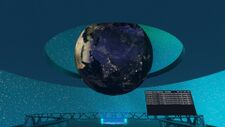- This world is made by the community.
Ikani's Eathquake Observatory is a world by Ikani for MMC 2024
The world can be accessed with: resrec:///U-Ikani/R-e0572985-57f2-4937-89ac-0e6820447e46
Description
The world features a (nearly) real-time display of any seismic events from around the world, polling data every 10 seconds from the USGS and displaying it both in list form, and on a 1/1,000,000 scale globe. The globe also displays the capital city of every country, along with the population of that city.
Control of what events are displayed is handled from the top of information board, where you can select the age and scale of events to be displayed. The options are:
- All events in the last hour
- 2.5+ magnitude events in the last day
- 4.5+ magnitude events in the last week
- Significant events in the last month
You can also click on any of the listed events to have that event highlighted on the globe.
For any events that have occurred within the last 10 minutes, a chime will sound, depending on the magnitude of the event. Controller haptics will also be set off. Blame Ohzee. You will also be able to see the P-waves (~6km/sec) and S-waves (~4km/sec) expanding out from the epicenter in realtime, giving an estimate of how quickly the shaking propagates, and how far. This is of course just an estimate.
In the case of multiple close by events, labels will stack, so as not to collide, with the oldest event labels the furthest out from the globe.
Beyond the observatory itself, there is also an info board that lists USGS earthquake myths, and the science behind them.
Future Plans
In the future, the plan is to include historical events, so that a visualization of how impactful those events were can be shown. I would also like to add support for GlobalQuake, which is a software that does real-time analysis of raw seismic station data, allowing for slightly less accurate, but much faster detection than USGS provides.
